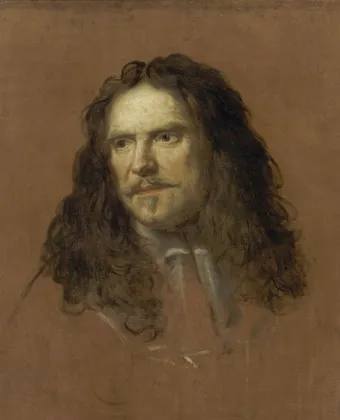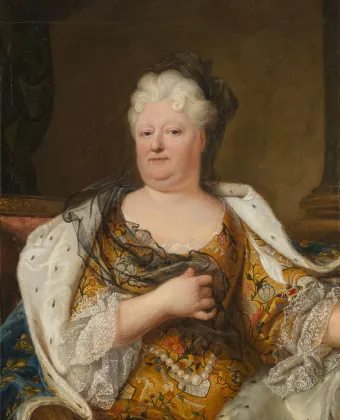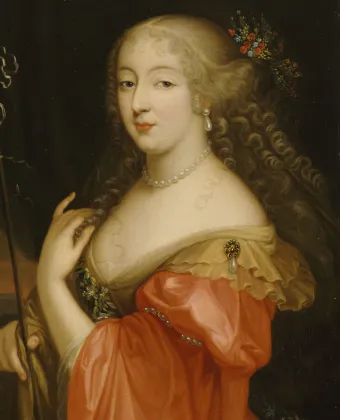The Royal Family
Acclaimed as “Louis the God-given”, arriving as he did after a 23-year wait for an heir, Louis XIV was born in Saint-Germain-en-Laye in 1638. Taking the throne at the age of four following the death of his father, King Louis XIII, the young monarch received a thorough education from his mother Anne of Austria and his godfather Cardinal Mazarin. While his mother ruled as regent and Mazarin busied himself with the young king’s political training, a civil conflict known as the Fronde broke out (1648-1653). Originating as a dispute between the monarchy and the Parlement de Paris, the rebellion subsequently spread to the aristocracy. The child king felt humiliated by the arrogance of the great lords and physically threatened in the capital. He would never forget this experience.
Louis XIV married his cousin (on both sides) Maria Theresa of Spain, the Spanish Infanta, at Saint-Jean-de-Luz in 1660. Their marriage sealed the reconciliation between France and neighbouring Spain. The royal couple had six children. Only the eldest, Louis de France, known as Le Grand Dauphin, would survive to adulthood. After the death of the queen in 1683, the King secretly married Madame de Maintenon. She was the last in a series of official mistresses which had included Mademoiselle de La Vallière and Madame de Montespan, with whom he had several legitimated children.
From royal residences to the Palace of Versailles
Until the official inauguration of the Palace of Versailles on 6 May 1682, the royal court often changed locations. Louis XIV and his courtiers were based in the Louvre Palace, then the Tuileries, alternating with stints at the Châteaux of Saint-Germain-en-Laye, Vincennes, Fontainebleau and the rapidly-growing Versailles. The task of building and decorating the ultimate royal residence was entrusted to artists such as André Le Nôtre, Louis Le Vau, Charles Le Brun and Jules Hardouin-Mansart. In 1678 work began on the Hall of Mirrors, the most potent symbol of the King’s absolute power. With enough room to house the whole court, the Palace and its surrounding buildings rapidly became symbols of an age when the nobility were prepared to go to any lengths to be close to the King, who respected the royal tradition whereby the monarch had to be accessible to his courtiers. Under the sovereign’s watchful eye, the nobility could no longer plot against the throne; the great lords were kept in their place in the army or at court, eager to serve and please the King. Intimidating, majestic, kept informed by an army of spies, the king controlled everything.
A royal art-lover
The King cultivated a broad variety of interests and excelled in numerous fields, such as music (he played the guitar), dance (performing in ballets), and horse-riding (Louis XIV was an excellent rider). He also loved hunting, promenades, fencing, shows and parlour games, and was a great fan of billiards. He surrounded himself with the leading artists and writers of his day, including Molière, Lully and Racine. At the Palace of Versailles he staged the finest comedies, operas and tragedies and organised spectacular parties.
King by divine right
At the start of his reign, before turning to more political allegories, Louis XIV chose the sun as his personal emblem. The sun is the symbol of Apollo, god of peace and the arts; it is also the star which gives life to all things, rising and setting with unfailing regularity. Like the god, Louis XIV was a warrior fighting to restore peace; he was also a patron of the arts and the source of all privileges. Though the unstinting regularity of his life and with the public getting-up and going-to-bed ceremonies, he hammered home the symbolic parallels. The Palace of Versailles is replete with representations and allegorical allusions to the sun god (laurel wreathes, lyres, tripods) combined with royal portraits and emblems.
An absolute monarchy
As sovereign by divine right, the King was God’s representative on earth. It is in this respect that his power was “absolute”, which in Latin means literally ‘free of all restraints’: the king was answerable to no one but God. During his coronation, Louis XIV swore to defend the Catholic faith. To honour this pledge and preserve the religious unity of his kingdom, he cracked down on the Jansenists of Port-Royal and ordered the persecution of Protestants. The previous policy of religious tolerance was abandoned with the revocation of the Edict of Nantes in 1685. Protestants were forced to convert, and over two hundred thousand fled the country. From his base in Versailles, Louis XIV ruled over a centralised, absolutist state which revolved entirely around him. The King lived in the main wing of the palace, on the first floor, in a suite of three apartments reserved for his use. He applied a strict etiquette at court, a set of rules and protocols by which his noble courtiers were obliged to abide. With the help of Colbert, he oversaw the administrative and financial reorganisation of his realm, and also set up manufactures and worked to boost trade. With Louvois he reformed the army and enjoyed a string of military victories.
After 72 years on the throne, Louis XIV died on 1 September 1715. He was buried in the Saint-Denis Basilica, and the throne passed to his great-grandson Louis XV, aged five.
Louis XIV continues to embody the Grand Siècle, synonymous with the splendour of Versailles and the glory of France.















